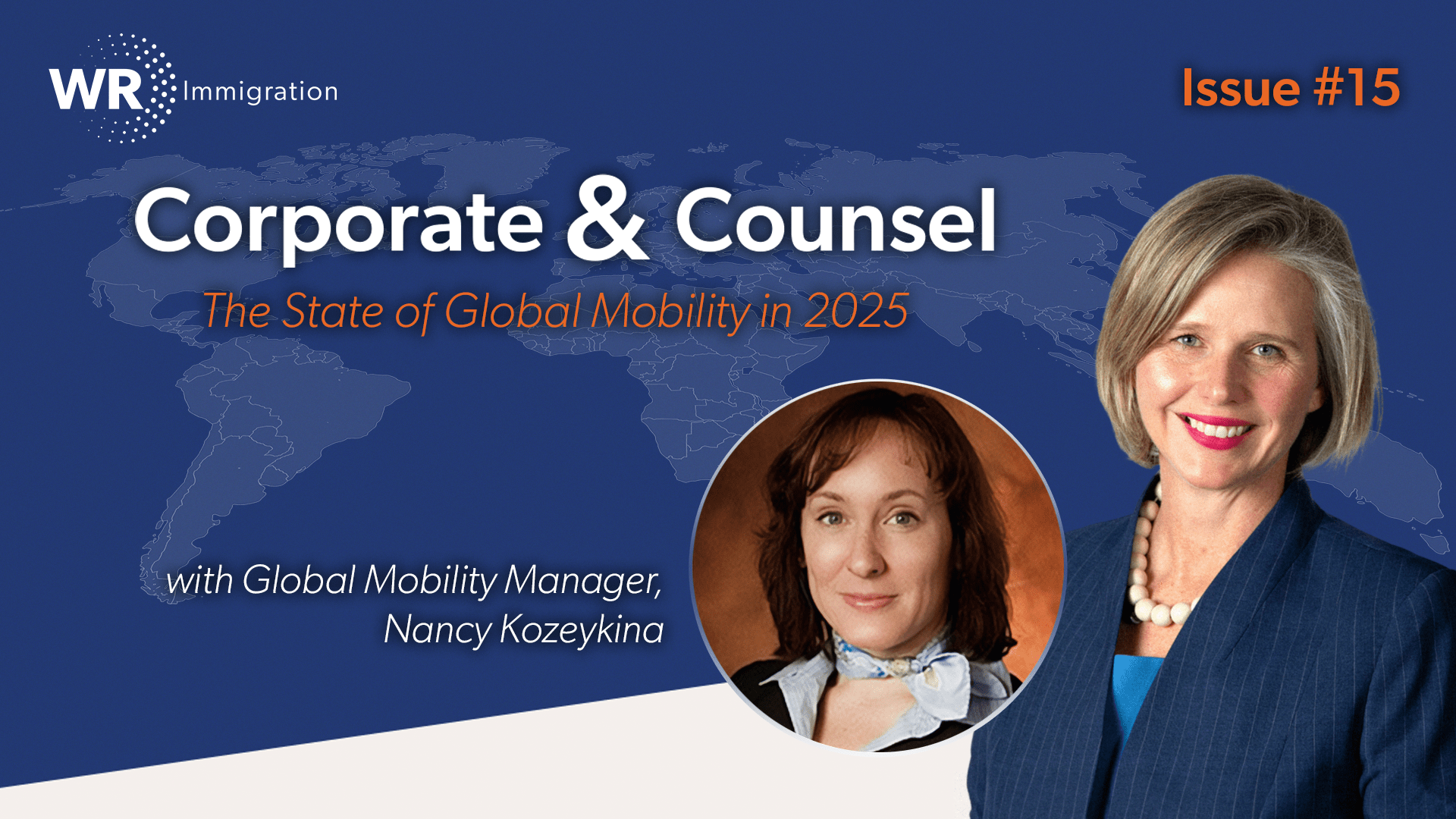The Consequences of the Drive for Cost Containment and Efficiencies within Global Mobility Programs
Disclaimer: These are individual comments/points of view from experts in the field based on their professional experiences which do not necessarily reflect companies’ official stands on certain topics or matters.
This newsletter series delves into the challenges and innovations shaping global mobility and immigration program management. My goal is to learn directly from in-house legal teams and immigration managers about how to better serve their programs. By fostering stronger partnerships, we can improve the immigration experience for employees, businesses, and stakeholders alike. From time to time I also interview seasoned experts.
Global mobility is undergoing a seismic shift in response to changing policy. Restrictive government measures have caused employers to take a cautious approach. Employers are cautiously navigating government restrictions while balancing office returns with employees’ desire for flexibility. Companies leverage technologies to retain top performers globally while exercising cost containment. Amid this evolution, in-house teams, working closely with outside immigration counsel, play a pivotal role in balancing compliance with business objectives—ensuring programs run smoothly while supporting strategic workforce initiatives.
In today’s dynamic landscape of global mobility focused on cost containment, I’m pleased to introduce Nancy Kozeykina—a seasoned leader with a truly global perspective. With over 15 years of experience across premier firms such as EY and KPMG, Nancy has cultivated deep expertise in international taxation, global mobility strategy, and compliance.
Currently serving as Global Mobility Manager at Ball Corporation, Nancy plays a pivotal role in steering mobility programs that support talent across borders. Her background is uniquely international, having led teams in Moscow, Lausanne, and now from Colorado. She also holds a Master’s in Taxation from Northeastern University and is a licensed CPA in New York. What sets Nancy apart is her strategic grasp of the tax implications of global assignments, coupled with her personal experience as an ex-pat. This confers upon her the the unique ability to harmonize the human element of mobility with compliance with business priorities. Her multilingual capabilities and global leadership lens make her a trusted advisor and an asset to any cross-border initiative.
Nancy’s blend of technical depth, leadership, and cultural fluency makes her a standout in the global mobility space.
Ceri: You’ve held significant roles across the U.S., Europe and Russia. How have these diverse experiences shaped your approach to global mobility management?
Nancy: My professional roles across the U.S., Europe, and Russia—combined with personal experiences living and working abroad both as a single employee and then later with a family —have shaped a deeply empathetic and agile approach to global mobility. These firsthand experiences provided a deep understanding of the emotional and logistical complexities of relocation: adapting to new cultures, navigating family transitions, and operating within unfamiliar systems. These experiences drive my commitment to developing mobility programs that align strategic business objectives with employee well-being.
Ceri: After extensive experience in tax advisory roles, what inspired your transition into global mobility management at Ball Corporation?
Nancy: With over two decades of experience in expatriate tax, transitioning to an in-house global mobility role represented a natural progression in my career. My extensive tax background with the Big 4 offered valuable insight into compliance, cost management, and the multifaceted challenges of international assignments. At Ball Corporation, I saw an opportunity to integrate this technical expertise with a people-centered approach, designing comprehensive mobility programs that support seamless relocations and promote employee success. This role has allowed me to make a meaningful impact, both on individual experiences and organizational outcomes.
Ceri: What are the key leadership lessons you’ve learned throughout your career at the Big 4 and now in-house?
Nancy: Adaptability is everything. At the Big 4, the pace is fast and client needs shift constantly, so I had to learn to be flexible without sacrificing quality. That skill translated directly into my in-house role, where priorities can change based on internal strategy or market forces. Whether advising external clients or working internally, good leaders align their work with business goals. That strategic thinking, understanding what matters to the organization and aligning efforts accordingly, has been critical throughout my journey.
Ceri: How has the push for cost containment impacted the structure of global mobility programs?
Nancy: The drive for cost containment has led many organizations to streamline their global mobility programs by centralizing processes, reducing the number of expats on long-term assignments, and shifting toward lower-cost alternatives like permanent transfers, local-plus packages, or short-term assignments. While this reduces immediate spend, it can create challenges in maintaining talent development pipelines and consistent global leadership presence.
Ceri: What are the risks of prioritizing efficiency over experience in global mobility?
Nancy: Prioritizing efficiency can lead to a “transactional” experience for assignees, where the focus is on logistics rather than long-term support and integration. This risks lower satisfaction, assignment failure, and even retention issues post-assignment. If employees feel unsupported or overwhelmed, it can diminish the ROI of the assignment altogether.
Ceri: Can cost containment strategies undermine talent management goals?
Nancy: Absolutely. When mobility is driven solely by cost, high-potential talent might miss opportunities to grow through international exposure. Companies may hesitate to send junior leaders abroad due to costs, focusing instead on relocating only critical roles. Over time, this narrows the leadership pipeline and limits global readiness among future executives.
Ceri: How can organizations balance efficiency with personalization in mobility programs?
Nancy: Many companies are increasingly using technology and tiered policy frameworks to strike this balance. By segmenting mobility offerings based on business need and assignee type (e.g., executive vs. developmental), they can personalize experiences without inflating costs. Additionally, AI and automation tools help improve efficiency in logistics while still allowing for human support in high-touch areas like settling-in services or family support.
Ceri: What unintended consequences have companies faced when cutting mobility costs too aggressively?
Nancy: Some companies have seen decreased assignment success rates, poor repatriation planning, and even compliance issues due to underinvestment in tax/legal support. Others report lower engagement scores among mobile employees, especially when families aren’t adequately supported. The key is finding savings without sacrificing the employee experience or regulatory compliance.
Ceri: How has the push for cost containment influenced companies’ reliance on external vendors in global mobility?
Nancy: Cost pressures have significantly increased companies’ reliance on third-party vendors to manage relocation logistics, tax compliance, immigration, and other mobility services. Outsourcing allows internal mobility teams to stay lean and scalable, but it also means organizations are more dependent on vendor performance and responsiveness. The challenge is ensuring vendor quality doesn’t decline as providers themselves push for efficiency through automation or offshoring.
Ceri: What trends are you seeing with vendors offshoring global mobility services, and what impact does that have?
Nancy: Vendors are increasingly offshoring service functions—like assignment coordination, document processing, and even some advisory services—to lower-cost delivery centers, often in India, Eastern Europe, or South America. While this can reduce costs, it sometimes leads to longer turnaround times, communication gaps, and a less personalized experience for assignees. The key risk is that the human-touch elements of mobility—especially during stressful relocation moments—may be lost in the name of scale.
Ceri: How can companies maintain high-quality service while using offshore or lower-cost vendor models?
Nancy: It comes down to strong vendor governance and clear performance metrics. Companies should implement robust SLAs, quarterly or annual reviews, and escalation protocols. Periodic training, shadowing, and knowledge sharing between offshore teams and client stakeholders also help maintain consistency. Some organizations also retain a hybrid approach—offshoring transactional work but keeping high-touch functions closer to home.
Ceri: In your view, what’s the ideal balance between in-house expertise and vendor reliance in today’s mobility environment?
Nancy: A blended model works best. In-house teams should own strategic planning, policy governance, and assignee relationship management—especially for key talent or complex cases. Vendors are great for operational execution and scale, but oversight is essential. Companies that invest in vendor partnerships rather than just vendor contracts tend to get the best results.
Ceri: What advice would you give to professionals looking to grow in the global mobility or taxation space? What advice would you give outside counsel and consultants seeking to improve your experience and the experience of the employees you serve?
Nancy: Stay curious and proactive. For professionals looking to grow in the global mobility or taxation space, my advice is to invest time in understanding the lived experiences of globally mobile employees. Don’t just learn the tax codes and compliance rules, but also understand how cross-border transitions impact families, careers, and day-to-day lives. Empathy, adaptability, and a global mindset are what distinguishes truly great global mobility professionals.
For outside counsel and consultants, strong communication, clear and timely solutions, and a partnership mindset are essential. Compliance is key — getting it right builds trust and opens the door to larger, more strategic engagements. Tailoring your approach to the realities of cross-border work further strengthens your credibility and value.


